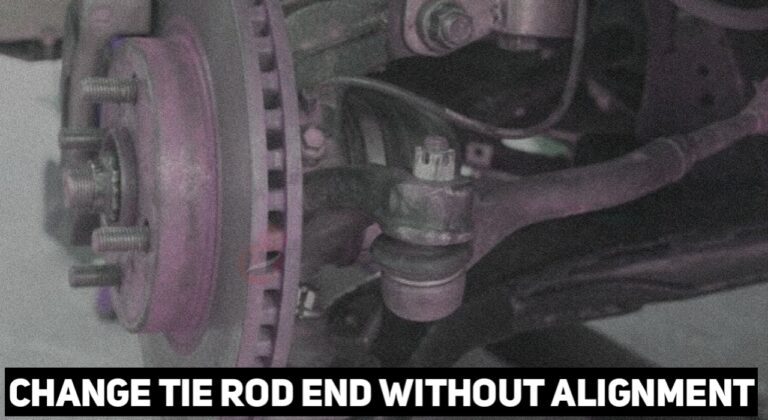Changing the tie rod ends requires a wheel alignment to ensure proper steering and eliminate premature tire wear. However, there may be instances where a quick replacement is needed Without an immediate alignment.
In this article, I’ll teach you a step-by-step guide on how to change tie rod ends without alignment.
The inner and outer tie rod ends in a vehicle ensure that the steering system is connected to the wheels; if it becomes rusty or damaged, you may notice signs such as uneven tire wear, excessive steering wheel play, or a clunking sound when turning. This calls for immediate replacement.
Can you change tie rods without alignment?
The straightforward answer to the question is a NO. This is because when installing new parts on a vehicle, there must be a slight difference from the last part, which will need you to align it to suit other components.
Without the alignment, you must replace your tires frequently or have a loose or unresponsive steering wheel.
Notwithstanding, there is a way to change the tie rod by yourself, and you can drive it without alignment, but you’ll have to visit a mechanic for proper alignment.
How To Replace a Tie Rod End Without Needing an Alignment
Here’s a breakdown of changing your tie rod end Without an alignment.
- Remove the pin located above the bolt.
- Loosen the bolt
- Use a wrench to loosen the end bolt of the tie rod with the aid of an adjustable
- Take off the main bolt from the knuckle assembly.
- Rotate the tie rod off the internal link (count the number of times it took to take it off and take note of it)
- Compare the new tie rod with the old one and ensure they’re equal.
- Install it with the exact amount of spin it took to take it out.
- Install the bolt and nut it before tightening the internal link.
- Test drive your car.
Now, let’s broaden the replacement process.
Raise the Vehicle.
This task concerns the wheels, so lifting the vehicle to get a clearer view of our workspace is necessary.
Start by losing the lug nut on the front wheels, jack the vehicle, and remove the tires to access the rotors.
Loosen and Detach the Tie Rod End
Located the tie rod end, which is connected to the steering knuckle. Remove the pin located above the bolt. Use a socket to loosen the nut securing the tie rod end to the steering knuckle.
Move to the other end of the tie rod assembly, which connects to the steering gear or rack. Use an appropriate wrench to loosen the locking nut securing the tie rod end.
Next, place a tie rod end puller between the tie rod and the steering knuckle and strike with a hammer until the tie rod end comes off (it’s not advised to hit directly on the head of the tie rod end).
Once loosened, unscrew the tie rod end from the steering assembly by rotating it counterclockwise. Take note of the number of rotations needed for removal, as this will help during the reinstallation process.
You may need to apply penetrating oil to help loosen rusted or seized components.
Install the new Tie Rod.
Get a tie rod of equal length and apply a small amount of grease to the thread for smooth installation. Thread the new tie rod into the steering assembly, matching the number of rotations recorded during removal.
Tighten the locking nut to secure the tie rod in place. Then, align the new tie rod end with the hole in the steering knuckle and insert the tie rod end stud into the hole. Screw on the retaining nut and tighten it to the manufacturer’s recommended torque specification.
You can repeat the above steps on other sides of the vehicle if necessary—also, endeavor to fully tighten the lug nuts using a lug wrench.
Test Drive Your Car
Before going for a test drive, you may want to visually inspect the tie rod ends to ensure they are properly installed and secured.
Once confirmed, take the vehicle for a short drive to check the steering response and listen for abnormal noises. Pay attention to the alignment of the steering wheel and how the vehicle tracks straight.
If you notice any irregularities, it is advisable to schedule a professional alignment as soon as possible.
Go for a Wheel Alignment
While replacing tie rod ends without an immediate alignment is possible, scheduling a wheel alignment at your earliest convenience is crucial.
Driving without a proper alignment can lead to uneven tire wear, compromised steering control, and decreased vehicle stability.
How to Change Tie Rod End Without Alignment VIDEO
FAQs
Why do you need an alignment after replacing tie rod ends?
After replacing tie rod ends, alignment is necessary to ensure the wheels are properly aligned and the steering system functions optimally. Replacing the tie rod ends restores the connection between the steering system and the wheels. However, the alignment settings may be disrupted during the replacement process, requiring an alignment to realign the wheels. A proper alignment ensures that the wheels are parallel, perpendicular to the ground, and aligned with each other.
Do tie rods affect power steering?
Yes, tie rods are the main component of a steering assembly that helps your wheels respond to steering inputs. Once it becomes faulty, your steering becomes unresponsive or difficult.
How can I make my car steering straight?
Performing a wheel alignment is the surest way to make your car steering straight. This ensures that the wheels are parallel, perpendicular to the ground, and aligned with each other.
As an Amazon Service LLC Program Associate, V. Auto Basics earns from qualifying purchases. See Our Affiliate disclaimer.
